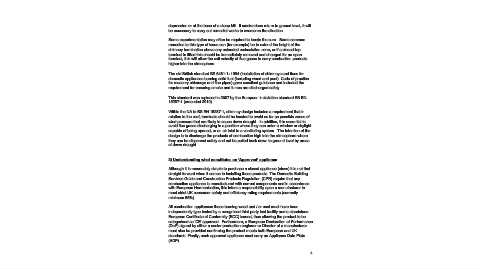Page 56 - Domestic Smoke Nuisance and Emissions Final_Neat
P. 56
depression or at the base of a steep hill. If smoke does return to ground level, it will
be necessary to carry out remedial works to overcome the situation.
Some experimentation may often be required to locate the cure. Some common
remedies to this type of issue can (for example) be to extend the height of the
chimney termination above any extended recirculation zone, or if a closed-top
terminal is fitted this should be immediately removed and changed for an open
terminal, this will allow the exit velocity of flue gases to carry combustion products
higher into the atmosphere.
The old British standard BS 6461-1: 1984 (Installation of chimneys and flues for
domestic appliances burning solid fuel (including wood and peat). Code of practice
for masonry chimneys and flue pipes) gave excellent guidance and included the
requirement for ensuring smoke and fumes are discharged safely.
This standard was replaced in 2007 by the European installation standard BS EN
15287-1 (amended 2010).
Within the NA to BS EN 15287-1, chimney design includes a requirement that in
relation to the roof, terminals should be located to avoid as far as possible zones of
wind pressure that are likely to cause down draught. In addition, it is essential to
avoid flue gases discharging in a position where they can enter a window or skylight
capable of being opened, or an air inlet to a ventilating system. The intention of the
design is to discharge the products of combustion high into the atmosphere where
they can be dispersed safely and not be pulled back down to ground level by areas
of down draught.
2) Understanding what constitutes an ‘Approved’ appliance
Although it is reasonably simple to purchase a closed appliance (stove) it is not that
straight forward when it comes to installing these products. The Domestic Building
Services Guide and Construction Products Regulation (CPR) require that any
combustion appliance is manufactured with correct components and in accordance
with European Harmonisation, this infers a responsibility upon a manufacturer to
meet strict UK consumer safety and efficiency rating requirements (currently
minimum 65%).
All combustion appliances those burning wood and / or coal must have been
independently type tested by a recognised third party test facility and a standalone
European Certificate of Conformity (ECC) issued, thus allowing the product to be
categorised as 'CE' approved. Furthermore, a European Declaration of Performance
(DoP) signed by either a senior production engineer or Director of a manufacturer
must also be provided confirming the product meets both European and UK
standards. Finally, each approved appliance must carry an Appliance Data Plate
(ADP).
4

